Bass fishing with fly rods is something you can only do with some knowledge. Our expert guide has easy-to-follow tips, tricks, and essential techniques that revolutionize your angling game. Our expertise will help you discover the best patterns and rod weights for maximum success, whether you’re a beginner or an experienced angler.
Can we catch Bass by fly rod?
Yes. Absolutely, It’s possible to catch Bass using a fly rod. A fly rod is often used to target trout and other freshwater species, but Bass can also be detected with a fly rod.
How to catch Bass for beginners? You don’t need to be a specialist to catch the Bass, the method is straightforward, and the tools are cheap and affordable. Here are a few pro tips that I stick to while catching the Bass with fly rods:
- Arrive first. Take this tip too seriously. I get up early in the morning when I plan to go fishing. If missed, I go before sunset at the spot. Indeed Bass eat the whole day, and their favorite time to come to the water’s surface is when the visibility is low, like early morning or before sunset. During summers, the Bass comes out at the dark of night. However, night fishing is also a good option, giving you a more unique experience.
- Finding Bass for fly fishing is a minor deal. It’s a versatile activity; you can find them everywhere, from rivers to ponds, lakes, and streams. Whether you own a fishing boat or prefer fishing from land, you can still target the Bass easily. Use the boat to reach the point where the water is deep, an ideal place for Bass to hide. While in the case of fishing shore, you can explore lakes, ponds, and streams. You can also use a kayak to get a wonderful experience.
- Prepare your mind for an intense battle; when Bass feel any danger, they don’t easily take the fly. They fight hard with all their power and energy for their precious life, resulting in aerial displays. To handle this, I always ensure I have some slack in the line; this absorbs the force generated by jumping and headshaking of the Bass. So, setting the hook properly: is essential to increase the chances of catching the Bass.
- It’s beneficial to look out for ideal weather for bass fly fishing. I considered Cloudy days because they have reduced visibility due to less sunlight and a soothing breeze that adds the natural movement in the water with an eye-catching view; the peaceful environment makes the Bass feel comfortable. For fishing in lakes and ponds, I prefer windless weather conditions. Also beneficial for making the flies visible to them. They attack flies without hesitation.
- One common thing between Bass and us is seeing how the food looks. Sounds funny..! But true. The clever Bass always notices the presentation of food.
Your fishing experience will only be great if the food presentation is natural. Bass have a strong sense, and the smell of any danger makes them go miles away from you. So, attract them with food that looks natural. Along with the presentation, I keep moving the flies in the water to create a more natural environment that forcefully attracts the Bass to their food.
- Always remember the distance of the cast is different for different Bass species. I target largemouth Bass from the cast distance is about 60 to 100 ft. While for smallmouth bass, casting up to 30 ft. is fair enough.
- Lastly, the retrieving movement of bass fly fishing is my most fun part. I make the artificial movement of the fly look so natural to attract the Bass. You can also do this by lowering the rod’s tip and pulling the line in different directions, creating a dancing motion that is likewise a symphony. A perfect signal is made to attract Bass.
Types of Bass:
There are different Bass species:
Smallmouth Bass:
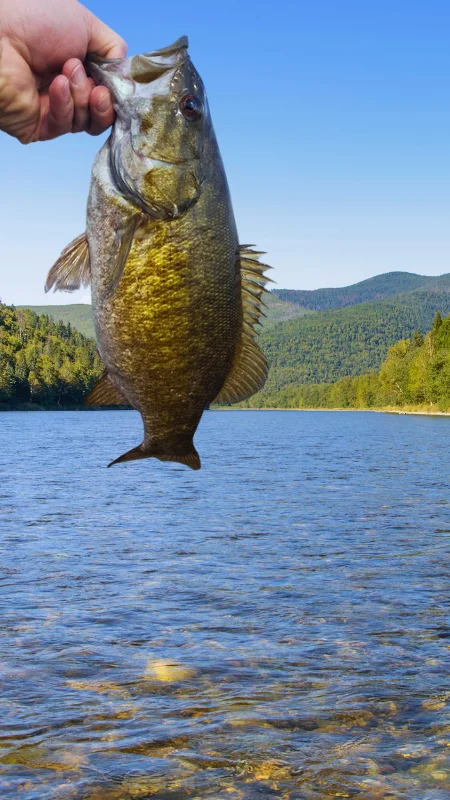
They have a shorter jawline than largemouth Bass and are bronze or brown at their back with vertical bars or stripes at their side. They have lateral lines across the body, which are less prominent. They prefer to live in cold moving water, such as rivers and streams, carrying moderate to slightly fast-moving currents and often hiding in rocks and deep holes. Although they are well known for their affinity for fresh moving water, they are also present in still water like ponds and lakes. They tend to seek protection under structures like fallen trees, roots, or dense vegetation.
Largemouth Bass:
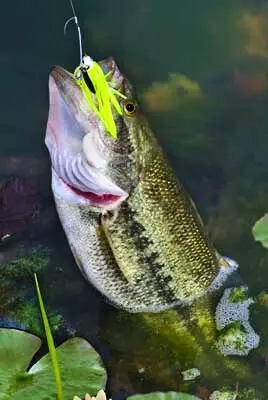
Largemouth Bass are well known for their voracious feeding behavior and distinctive features. They have jaws extended beyond the rear margin of the eye and have a deep green color body with visible black lines running horizontally across the body. These features make them recognized. They have a wide mouth, enabling them to consume prey.
They are primarily found in shallow and deeper places of water bodies like streams, lakes, ponds, and rivers. They prefer to live in musky and warm water and where there is an abundance of aquatic weeds or vegetation or in rocks as well as other underwater structures.
Alabama Bass:
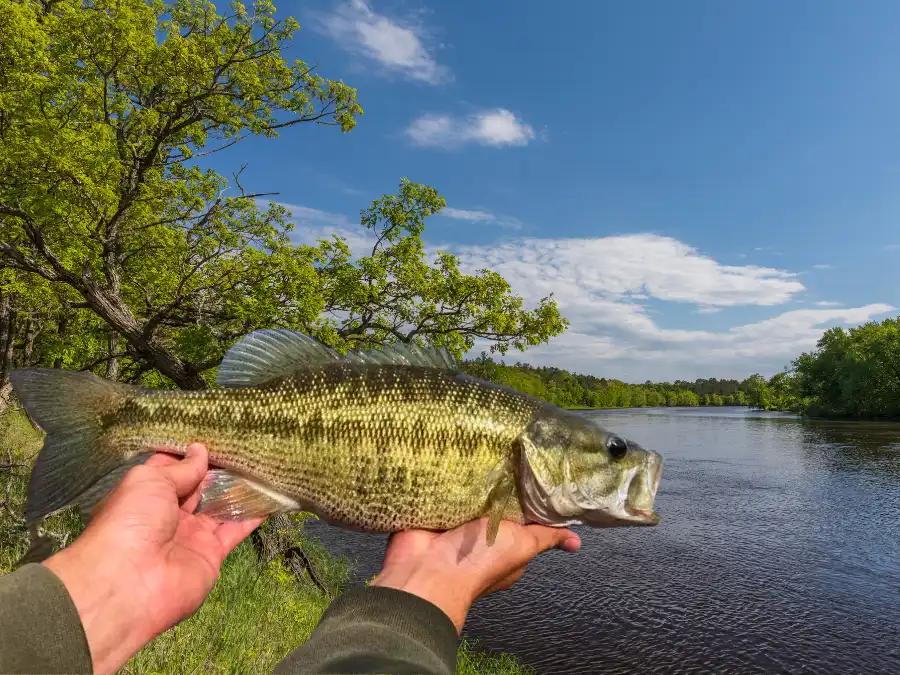
Alabama bass is dark, with tooth patches on their tongue, distinguishing features from others. This Bass has a blotchy lateral band that extends from head to tail, with spots below this band.
Guadalupe Bass
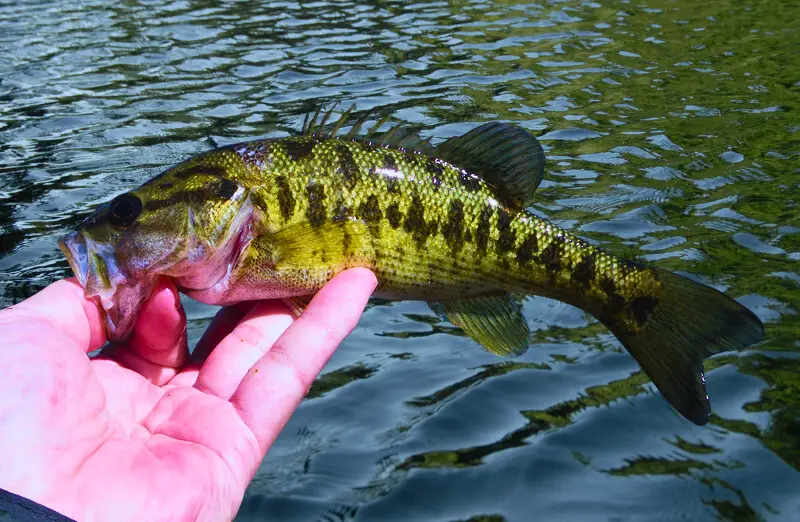
Guadalupe Bass is famous because it is only present in Texas and is also called “the fish of the state of Texas” or, Texas Trout.” They have a green color and lack a vertical bar on the body, just like smallmouth Bass. They don’t have extended mouths like largemouth Bass. Their lower body is colored like the sides of the body towards the belly. They are present in the flowing water in the streams and rivers in (central) Texas.
Note: Guadalupe is declining dramatically, so the Texas Perk and Wildlife Department has announced fishing tips and regulations. Anglers must be at least 17 years or older with a valid fishing license. Guadalupe bass has no size limit, but the daily bag limit is five fish (for any combination, including largemouth, smallmouth, spotted, Alabama, and Guadalupe Bass).
Fly rod for Bass fishing:
Many questions might have come to your mind about the perfect length and weight of fly rod for bass fishing. You also want to know about demanded power and action. Well, it’s a challenging task if you know about it.
Before making a significant investment. Why not get some authentic knowledge? It’s essential to avoid being influenced solely by marketing hype. Remember, if you know this information, an expensive fly fishing rod only guarantees the best fishing experience. So, let’s put the light on each query.
The perfect fly rod for bass fishing should be:
Moderate fast to fast- action:
Only readily jump into fast action if you are well confident. It has little flex and more power, fighting for fish much quicker than slower action. If you know what you are doing and have enough courage to handle the timing with the technique simultaneously, go ahead. It is best to battle against larger fish, making longer casts under windy conditions. If you are a beginner, you will make a weaker cast, spend longer hours struggling in the water to get the spots, and become frustrated.
However, moderately fast or medium fast, which refers to the same action, is more versatile. You will need more power than fast action to fight against giant Bass under windy conditions. But still, it makes the fight more manageable by giving more flex. Experienced anglers widely use moderate-fast action along with beginners. Due to its medium action and limited power, I prefer a moderate-fast action rod for fly fishing Bass.
Moderate/ Medium Action:
Suppose you need to gain experience in fly fishing. In that case, a medium action is perfect, offering versatility and forgiveness that will not give you fast action and a little moderate-fast action. This balances accuracy and control by bending half of the rod while the other half remains stiff during the cast.
Medium action is suitable for all kinds of flies, and most importantly, it is affordable and cheap to practice at the beginner level.
These above characteristics of fly rods are perfect for fly fishing for Bass when casting heavy setups such as sink tips or weighted flies.
Length/size of fly rod for bass fishing:
What is the perfect fly rod length/size for bass fishing? The length/size should be 9 ft. This length is enough to provide a balance between the casting distance as well as control.
Weight of fly rod for bass fishing:
What is the perfect fly rod weight for bass fishing? Ideally, a 7-weight fly rod is ideal for bass fishing, as it provides enough power to fight with the larger bass species and pick a load of heavier flies with accurate presentations.
PRO TIP: What’s so special about 7 – weight fly rod for bass fishing? Anglers use 7-weight fly rods for bass fishing because of their versatility and power, which is enough to handle large flies, especially against wind. Additionally, this rod strength is enough to fight against the aggressive nature of Bass, allowing it to set the hook. The 7-weight fly rod with a 7-weight forward fly line is an ideal setup for my style, enhancing the casting performance and fly control.
But when and why should you use 5, 6, 8, and 9-weight fly rods for bass fishing? Let’s discuss each:
5 -weight:
This weight is a little heavy. You can use 5-weight for small Bass, so there’s no need to rush for a heavier-weight fly rod. However, keep in mind that it’s best to use for areas with fewer or no obstacles, like rivers, lakes ponds, and open reservoirs. The only limitation is that it could be more suitable for casting heavy flies.
6 – weight:
6 –weight fly rod has a bit more power and is perfect for casting weighted flies such as closures or small poppers. The weight provides enough ability to fight under windy conditions. The manufacturers also design small fighting butts to fight against big Bass by giving control to the angler during intense battles. 6 weight fly rod is preferred for fighting giant Bass in areas like open water with fewer hazards.
8 – weight:
You cannot doubt the versatility of an 8-weight fly rod for bass fishing. Here, I tell you why. It’s perfect for many fishing situations when power and strength are required, along with weighted flies like woolly buggers. Moreover, it allows you to do fishing in areas with heavy covers and against winds and can handle giant Bass. But also well for targeting smaller fish.
9 – weight:
Perfect for handling larger heavy flies, it does well against the wind. I prefer to use 9-weight fly rods in areas with heavy covers and obstacles.
I’m not excited to use it for catching smaller Bass. It only works well when hooking into giant aggressive Bass in thick fishing scenarios, with high demand for enough power and control.
Reels:
What size reel is best for bass fly fishing? Well, it’s essential to see the weight of your fly fishing rod when deciding the reel size. I use up to 7- weight reels to target smallmouth bass under calm conditions. In contrast, 8-weight reels are perfect for me, for largemouth Bass, with an adjustable dragging system that provides me flexibility when casting in various watersheds.
Fly lines:
Fly line selection depends on the type of flies you are going to and your fishing location (surface of water or at depth).
I use a weight-forward floating line in shallow water, such as ponds and lakes. But fishing where there is a lot of structure underwater, so short front taper is my best friend. Whereas, when fishing in water depth, a sinking fly line is my only option.
Let’s discuss different fly lines and when and why you would need to use each one:
weight – forward floating line:
If you will do bass fishing beneath the surface, use a weight-forward floating line. This is best for surface presentation. This fly line is widely used in lakes and ponds and can be paired with longer leader sinking flies.
Intermediate fly line:
You should shift to this fly line if you want subsurface presentation with slow sinking (sinks at a rate of 1 to 2 inches per second). When you feel the Bass are holding and feeding in water from 6 to 10 ft. in-depth, you can effectively pull a fly over a shallow weed bed.
Sink tip fly line:
It starts with a floating head and ends with a fast sinking line, this feature helps to reach the bottom more quickly, and I use it when fishing in shallow to moderate-depth water bodies that contain drop-offs, snags, and other structures.
Fast-sinking fly line:
As the name indicates, this fly line sinks much faster, like 6 to 10 inches per second, allowing you to take the fly at the desired depth of water. Best for deep water bass fishing.
Leaders and Tippet:
The leader should be large enough to catch the Bass. My preference is given to a length of 6 to 7′ leader; this length I can easily use for largemouth and smallmouth bass
How does the fly line choice impact the selection of a leader for Bass fishing? What are some general tips for selecting the right leader for bass fishing?
Again, the choice of leader will depend on the selected fly line, the size of your fly rod, and the quantity of cover present at the fishing
place.
A recommended 7.5 ft. tapered leader is fair enough when using the floating line. The breaking strength should be 12 to 15 pounds. This strength is sufficient for bass fishing with minimal covers or, in other words, you can say obstacles.
A shorter leader of about 3 to 4 ft. is ideally used with sinking lines with the same strength.
When you are using small flies in clear water conditions with few snags, you can opt for a lighter leader with 6 to 8 pounds of breaking strength. But when you are fishing in areas with heavy cover and using the larger flies, go for the more muscular strength of the leader, like breaking strength of 20 pounds is recommended for a memorable fishing experience.
Star of the show, the natural-looking Flies:
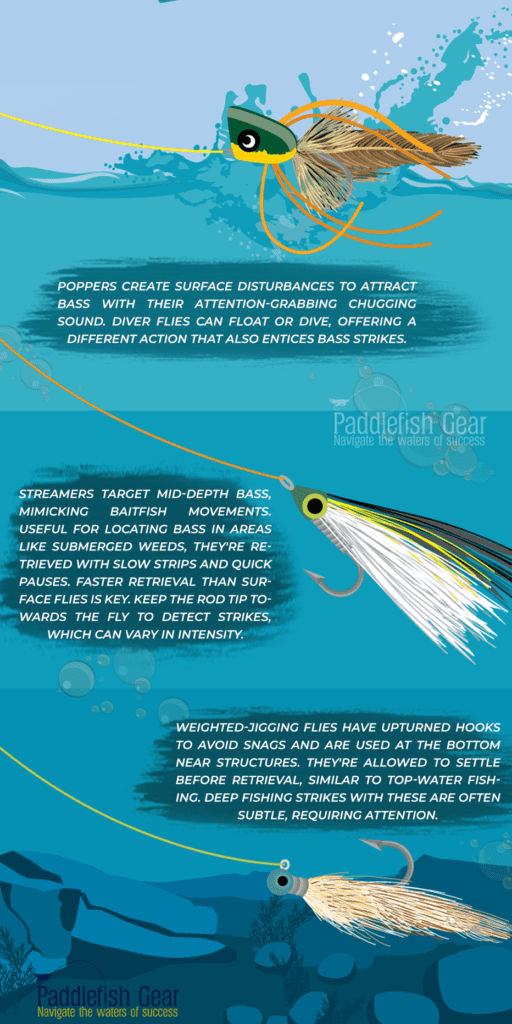
Attracting the Bass is integral but with the natural-looking food. Yes, read that again. Bass is an aggressive species with a clever nature. They will not eat everything you give them; instead, they move away from you if they sense any danger. So, fly selection is significant. Many kinds of flies, like floating bugs, streamers, and weighted jigging, are in the market. Each type of fly has specific characteristics, allowing you to fish at the upper to lower level, wherever the Bass is present.
The selection of flies is also based on some conditions like I choose big and noisy poppers and divers when the light is low and there is wind chop on water. This noise attracts the Bass. On the other hand, when the water is calm and peaceful, I prefer smaller bugs, sliders, and gurglers.
Floating bugs
include poppers, gurgles, divers, and sliders.
Poppers are meant to create disturbance in the upper level of water; they tend to attract Bass due to their upper attractive, attention-grabbing action. They have a cupped face that makes a chugging sound with every sharp tug.
Diver flies can float on water or dive in with the pulled fly line underneath the water. They have a bit different action than Popper and effectively entice Bass to strike.
Pro tip: I believe patience is a crucial factor in bass fishing. Fly fishing for Bass in ponds and lakes. I wait a few seconds to minutes once the fly has settled before moving it. The pause results in an exciting strike from Bass. If I don’t get any bite at this pause phase, I retrieve. Hold the fly rod tip low, pointed towards the fly to avoid any slack in the line. Slow retrieve with twitches, jerks, and long pauses favors the fast and noisy retrieve. I always keep my fly in the “strike zone” near the target area. If I cast into weeds and snags and slowly retrieve the fly without getting snagged is even more perfect. So, I keep trying different retrieval techniques and see what works best each day.
Streamers
are well when targeting Bass at the middle of water depth. These flies resemble baitfish and create a realistic movement to gain the Bass’ attention. These flies are helpful when you need clarification about the Bass’s specific location so you want to explore larger areas like the submerged weeds and shallow underwater structures. You can retrieve streamers with slow strips, pause for a moment, and let the fly attract Bass. It’s important to retrieve more quickly than surface water flies. These are best to explore more water. Keep the tip pointed towards the fly to feel the strikes. Strikes usually involve pressure or bumps on the line, aggressive hits, or rod bending.
Weighted-jigging
flies have a heavy head with an upturned hook, which prevents them from getting snagged. These are widely used at the bottom, like hollow logs, rock piles, or drop-offs. These flies allow you to settle down before retrieving, like top-water fishing. You must be more attentive because deep fishing strikes are more subtle.
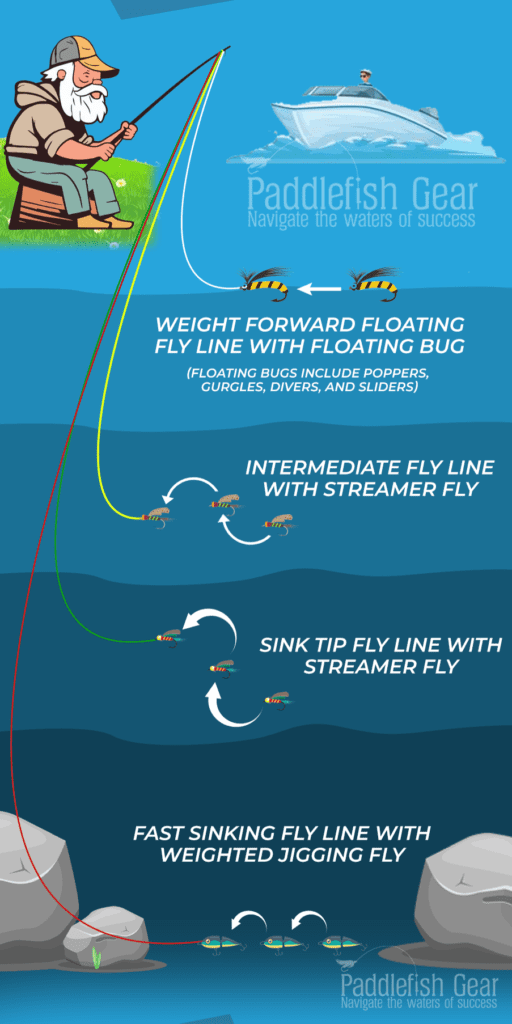
When to go for bass fly fishing:
Bass are active throughout the year, except in winter, when they become less active and move deep into the water. They love summers and spring, engaging them in average to moderate, mild water.
The start of spring, especially in the months of March and April, is an ideal time for catching the Bass with a fly rod. You can easily find them in shallows, where they seek warmth and enjoy their meal before the spawning season. Streamers like wooly buggers are effective in targeting them.
With increased water temperature, you’ll find them in deep water, where they seek protection in structures, deep holes, or drop-off waters.
In hot summers, after spawning, they are not interested in food. But they can recover quickly. You’ll find them in deeper-cooled water. The smallmouth bass like to live in cool flowing water, while the largemouth Bass are present in deep cooler water but still can be present near weed beds.
Summer is ideal for using floating lines, and surface flies to target Bass. You can use poppers. Bring your weed guard to prevent your fly and line from snagging around the deep water plants.
Before winter, Bass like to eat more, move together in groups, and follow bait fish, providing you more opportunities for multiple hookups.
Bass become more cautious in the fall when they are prone to spooking. You need to maintain a noiseless subtle approach to attract the Bass.
Fly fishing for Bass in winter needs to maintain consistent retrieve in extreme depth. It would help to keep your fly deep in the water as much as possible. Bass are less active in winter, so they take longer to strike. It’s essential to be conscious during the whole fight.
How to fight/catch Bass using a fly rod:
Bass have an aggressive nature; they fight back with all their power and strength. So, a different approach is required to catch them other than trout fishing. Anglers need practice to handle them, especially in areas of heavy cover, where they are mostly found.
You must know the hook set properly if you want to catch Bass. Fly fishing for largemouth Bass have big mouths with bony jaws, making it tough to hook them with long, flexible fly rods. For this, I use a regular bass fishing rod and apply the strip set technique.
Here’s how it works, on every bass strike, I give a strong, steady pull on the fly line with the tip pointed at the fish. This direct connection gives more power to penetrate the bony jaw of the Bass.
The fight begins right after the fish is hooked. I assure to that bend the fly rod at 45 degrees to regulate pressure on the Bass. I keep the line tight and prevent the fish from any obstacle, allowing the Bass to swim into. Fish is lost when the slack develops in the line. So, it would be best if you used the right strength leader.
Heavy tippets can be used to catch heavy Bass, where you must use a reel.
I fight hard to bring them onto land; they quickly release them back to water in a healthy state to fight for the next day, and so on.
What gear should I consider for bass fishing with fly rods?
Generally, I take these things with me no matter what time of the year I’m going fishing.
- Fly rods (reels, lines, flies)
- Light
- Batteries
- Hat
- Sunglasses and sunscreen
- Chest or hip pack
- Wading boots
- Bug spray
- Binoculars
Best Locations for Bass fly fishing in the USA:
Bass is everywhere. You have already heard this sentence. There are countless spots where you can find them. Out of too many, here are just a few best locations for bass fishing:
- Texas ( Sam Rayburn Reservoir, best for largemouth Bass)
- Michigan (Lake St. Clair)
- Florida (The Everglades)
- California (Clear Lake)
- Texas – Oklahoma (Lake Texoma)

2 thoughts on “BASS FISHING with fly rod: Where, When, and How-To Guide”